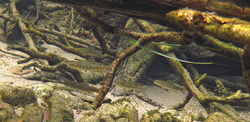Placement of dead wood and debris
Contents
Introduction
The placement of dead wood in the river can be an efficient measure in rivers with limited shelter and morphological variation, being an alternative to placement of stones and larger substrate in the river (Pulg et al 2017). In addition to shelter and more morphological variation dead wood would gradually degrade and provide organic material to the river. The size and the exact placement of the dead wood should be done after considering the variations in the local hydraulic conditions, but it seems like this measure is less suitable if the rivers are steep.
It should be assessed if the placement of wood in the river would affect the conveyance capacity during floods. If the river is used for navigation, transportation of timber, etc., placement of wood in the river is probably a less feasible measure.
Methods, tools, and devices
During planning
The approach to assess the suitability of this measure would be to investigate if shelter and morphological variation seem to be limiting the development of the fish populations. If this is the case, the introduction of dead wood should be considered introduced, on equal basis with other measures mitigating the same problem. If the conveyance capacity is critical, the effect of the introduction dead wood should be considered. Standard tools for hydraulic calculations can potentially be used, but according the authors' knowledge, this has to a very little extent been done.
During implementation
Access to local wood would make construction of this measure very simple, by simply bringing a chain saw and dragging the timber to a proper place in the river where the wood would not drift away as soon as the water level increases.
During operation
There is basically no maintenance needed for this measure, except that the process of adding dead trees might be needed to be repeated if the wood is gradually degraded or drifts away in larger parts. Monitoring of the effect of the measure can be done by for instance electro-fishing in order to assess the density of juvenile fish and compare this to densities in sections where shelter is limited.
Relevant MTDs and test cases
Classification Table
| Classification | Selection |
|---|---|
| Fish species for the measure | Gravel spawners |
| Does the measure require loss of power production | - |
| - | |
| Structural (requires no additional flow release) | |
| Recurrence of maintenance | Less often than yearly |
| Which life-stage of fish is measure aimed at | Spawning / Recruitment |
| Juveniles | |
| Adult fish | |
| Movements of migration of fish | |
| Which physical parameter is addressed | - |
| - | |
| - | |
| Substrate and hyporheic zone | |
| Water temperature | |
| - | |
| Water velocity | |
| Water depth | |
| Hydropower type the measure is suitable for | Plant in dam |
| Plant with bypass section | |
| Dam height (m) the measure is suitable for | All |
| Section in the regulated system measure is designed for | - |
| - | |
| Bypass section | |
| Downstream outlet | |
| River type implemented | - |
| Fairly steep with rocks, boulders (from 0.4 to 0.05 %) | |
| Slow flowing, lowland, sandy (less than 0.05 %) | |
| Level of certainty in effect | Moderately certain |
| Technology readiness level | TRL 9: actual system proven in operational environment |
| Cost of solution | See cost table |
Relevant Literature
- Pulg, U., Barlaup, B.T., Skoglund, H., Velle, G., Gabrielsen, S.E., Stranzl, S.F., Espedal, E.O., Lehmann, G.B., Wiers, T., Skår, B., Normann, E., Fjeldstad, H-P. 2017. Tiltakshåndbok for bedre fysisk vannmiljø: God praksis ved miljøforbedrende tiltak i elver og bekker. Uni Research AS.
